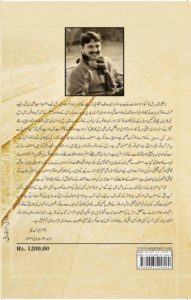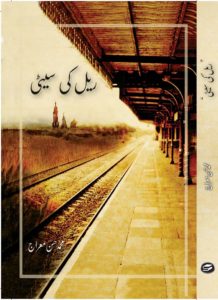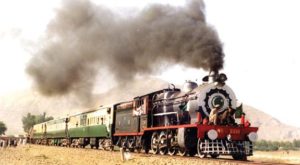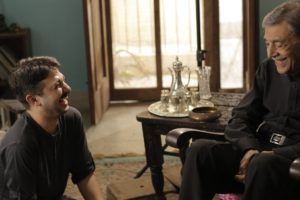

Mohammed Hasan Miraj is a Pakistani writer who served in the army, was stationed at Siachen glacier and then worked in ISPR (Interservices Public Relations) where he made at least one movie and then retired as a major and went to the London School of Economics to earn a degree in communications. While working for ISPR, he wrote several very nice articles in Dawn newspaper, almost all of them little travel pieces about various places in Pakistan; these articles are rich with history and folklore and display an erudite, liberal, tolerant and sagely tragic spirit; they are also obsessed with the romance of train travel.
This apparently lifelong fascination with travel, history and trains has now been poured into his first Urdu book, a small gem called “Rail ki Seeti” (the train whistle).

Hassan Miraj follows the railway line from Rawalpindi down to Uch Sharif, with abundant branching trips along the way (basically covering Punjab, from North to South and East to West) and writes about almost every station along the way (including some stations that no longer exist or function). He gives us little tidbits of local history and anecdotes about celebrities and historical figures that originated from each terminus. He has clearly read widely and has managed to interview many people who remember events and people who are no longer with us. Like any rational and empathetic person, he is filled with endless sorrow and angst at the partition of Punjab and the destruction of its composite culture and humanity in 1947. At every stop, he remembers the Sikhs and Hindus who once lived there and the multiple tragedies and atrocities that befell these towns in the holocaust of partition. As a result, the book really reads like an elegy for United Punjab, now gone and not likely to be put together again in the foreseeable future; in fact, as his book (especially the chapters on Jhang, Khanewal, Shantinagar and Rabwah) make clear, the trend is irrevocably in the opposite direction.
But with all this, I would still give the book 4 stars and not 5. Why?
1. The book works better if you already have a general idea of the history of the region and some familiarity with the artistic and literary celebrities of the early 20th century. If not, you may not get what the fuss is about. While he gives us a lot of information about each specific city or it’s leading lights, there is no attempt to provide the reader with any overall picture of the history of Punjab, or for that matter, about the events of partition. This is not a defect as such, since this is exactly how books like this are usually written, but it does mean that books like this mean much less to outsiders and those who have no prior interest in the subject.
2. The books is written in the best traditions of “high church” literary Urdu prose, which means its language is flowery and ornate. Again, this is a selling point for many readers, but I don’t read a lot of Urdu, and I tend to tire of this style by page 174. That’s just me. More significantly, he also follows the genteel tradition of never speaking ill of the dead (and whenever possible, not even of the living) to the nth degree. Except for a few fanatics, who are damned by not being praised, everyone is treated with exaggerated respect and elaborate courtesies. Again, this is probably a selling point for many, but I would have preferred the occasional criticism. It does make you think, if every significant person in Punjab was such an angel, how and why did the place descend into genocide and ethnic cleansing on a scale rarely seen even in the blood stained history of the 20th century? Inquiring minds want to know, and Hasan probably has some profound observations on this topic, but he chooses not to share them in this book. This is probably due mostly to his generous and forgiving nature, but who knows, some of it may be in the category of “discretion is the better part of valor”.

He has a fondness for local legends and he does not always feel it necessary to clearly separate historical fact from folk mythology, but this is not a major failing, since the context usually makes the distinction abundantly clear. Those who are familiar with our folklore will enjoy the references, those who are not, may be stimulated to read more. Overall, the book is a fascinating, informative and stimulating journey through our beloved Punjab; sometimes it is also unbearably sad. So is history.
Well worth a read.

